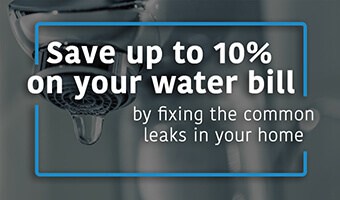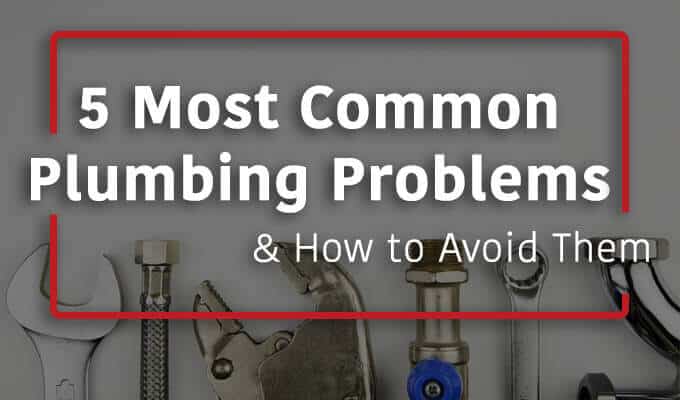What Are The Most Common Plumbing Problems?
The most common plumbing problems are clogged drains and toilets, leaky faucets and pipes, water heater issues, low water pressure, and a running toilet. Each of these issues requires a different solution that we will cover below.
You don’t realize how much you rely on plumbing until you start having issues. A dripping faucet here, a slow drain there — as your home ages, it’s natural to have some plumbing problems. Some of those issues are simple enough to DIY without much difficulty. Others come with some potential dangers and are better left to the professionals. Being aware of the common plumbing problems and solutions helps you know when to grab your tool belt and when to call the plumber.
Clogged Drains and Toilets
You can spot clogged drains when you see water backing up as you empty a sink or take a shower. For a toilet clog, the signs are often more immediate. Instead of flushing normally, the water backs up in the toilet bowl and may even overflow. Clearing the blockage typically restores your drains or toilet back to normal with a little DIY work or a visit from a plumber.
- What Causes the Problem: Slow or clogged drains occur when something blocks the drain partially or completely. In sinks and showers, hair is often the culprit, but other items, such as a shampoo lid or small toy, may enter the drain and block the pipe. In toilets, the problem often comes when something other than dissolvable waste enters the toilet and gets flushed. Those solid items cannot move through the pipe, so they stay put, making it difficult or impossible for water to flow past the blockage and down the pipes.
- How to Fix Clogged Drains and Toilets: Start with a plunger to help remove the clog. A plunger works on both toilets and on drains. The simple plumbing tool helps loosen clogs using air pressure. Place the open end of the plunger completely over the drain and move it up and down to create suction. If you can draw the blockage close enough, use tweezers or pliers to grab the clump and remove it from the drain. Chemical drain cleaners offer an option if you can’t remove the blockage with a plunger. Home improvement stores also sell plumbing snakes that can dislodge blockages to get the water flowing again.
- How to Avoid Clogging Drains and Toilets: Prevent toilet clogs by only flushing dissolvable waste products down the toilet. Watch kids closely so they don’t flush toys or other large items down the toilet. If something falls into the toilet, get it out instead of trying to flush it. In showers, use a hair catcher over the drain so loose strands don’t collect inside the drain pipe. Try to keep loose strands of hair out of sinks to prevent clogging.
- When to Call a Plumber: Let a professional handle clogged drains or a clogged toilet if you can’t easily remove the blockage yourself. Another time to call a plumber is when you get repeated clogs in the same drain. Using caustic drain cleaners can damage pipes over time with regular use. A plumber may be able to fix the problem to prevent future clogs without damage to the pipe.
View Our Central PA Plumbing Services
Leaky Faucets and Pipes

Leaking pipes can cause major damage if you don’t catch the problem immediately. You often spot leaking pipes after a period of time when you see a puddle below the pipes or hear dripping.
- What Causes the Problem: A dripping faucet typically occurs when the washer that forms the seal on the tap gets damaged. Damage may include tearing, dislodging or stiffening. When this damage occurs, the washer no longer seals tightly, allowing small amounts of water to drip from the faucet. Over time, the valve seat may also wear or corrode. If your pipes are leaking, the most likely location is at a joint. Leaks may occur due to deterioration, shifting, high water pressure or other damage.
- How to Fix Leaky Faucets and Pipes: In faucets, replacing the washer responsible for the leak solves the problem. This can be a DIY job, but replacing the washer is easier with specialty tools, so you may want to call a plumber. Leaking pipes may be a simple job or a very complex one. Even if you just need to replace a simple U-joint, it’s sometimes easier to let a professional handle the job to avoid a big mess.
- How to Avoid Leaky Faucets and Pipes: Natural wear from regular use is often difficult to avoid. Over time, leaking faucets are bound to happen. Slow that wear by turning faucets on and off slowly and avoiding excessive pressure on the handles. Leaky pipes are difficult to prevent, but you can spot the problem early with regular inspection. Look for moisture or small drips. Visible rusting or white lime deposits can signal the potential for leaking.
- When to Call a Plumber: Call a plumber to replace the washer if you don’t have experience with plumbing. For leaking pipes, call a professional when the job is too large or if you don’t want to mess with the clean-up.
Water Heater Issues
Water heater issues are usually easy to spot. You go to take that nice warm shower but instead get doused by freezing cold water. Dripping water, puddles of water, discolored water and noises coming from the water heater unit are other signs of a problem. In some cases, you can troubleshoot the issues yourself, but many water heater issues and repairs require professional help due to the complexity and potential for danger.
- What Causes the Problem: Leaks are sometimes the cause of water heater problems, including not having enough hot water. Mineral deposits also cause problems in water heaters. The deposits can reduce the efficiency of the water heater, reducing the supply of hot water throughout your home. Sediment can also cause strange sounds from your water heater, which are caused by heating and exploding of the sediment or build-up of scale on heating elements.
- How to Fix Water Heater Issues: Check the pilot light if the water heater runs on gas. If the pilot light isn’t on, the unit won’t produce hot water. Look at the temperature setting to ensure it wasn’t turned down accidentally. If you think mineral deposits are the issue, drain the water tank to flush out the sediment. If you see water pooling on the floor, call a plumber, as the tank is likely leaking and may need replaced by a professional.
- How to Avoid Water Heater Issues: Maintaining your hot water heater helps it run efficiently to prevent problems. Check the pressure valve regularly. Flush the tank periodically to remove sediment. Look around the tank occasionally to check for drips and leaks that could indicate a bigger problem.
- When to Call a Plumber: Unless the issue has a simple fix, such as relighting the pilot light or adjusting the water heater thermostat, call an experienced plumber when you have water heater troubles. Water heaters can be dangerous and repairs extensive, so it’s better to let a professional handle the work.
If the water heater issues cause water puddles on the floor, take a few immediate steps to ensure your safety. Here is what to do:
- Shut off the power to your water heater. For an electric water heater, ensure you are completely dry and wear a pair of work gloves to shut off the breaker that controls the water heater. For a gas water heater, use the shut-off valve at the connection point of the unit.
- Turn off the water to prevent additional leaking. You can shut off the valves to the water heater if they are functioning properly. If not, shut off the main water valve into your home until a plumber arrives to evaluate the situation.
- Move items away from the water heater.
Low Water Pressure
Common plumbing problems in old houses often revolve around low water pressure, but the issue can happen in new homes as well. Low water pressure can come on suddenly or slowly get worse over time, depending on the cause. Whatever the reason, low water pressure makes it difficult to rinse things and shower, so resolving the issue is a priority to get back to normal water use.
- What Causes the Problem: Low water pressure has a few possible causes. A water main break can reduce pressure to your tap – this could be the issue if your neighbors also suddenly experience low water pressure. That same loss of pressure happens if a pipe is leaking within your home. Shut off all taps, check your water meter and wait a few hours without using any water to check for leaks. If the water meter changes, you likely have a leak. Another potential cause is build-up of minerals and sediment either in the pipes or in the faucet aerators and showerheads. That build-up slows the water flow, resulting in low pressure.
- How to Fix Low Water Pressure: If you think build-up is the problem, start with the aerators or showerheads where you have the water pressure issues. Unscrew the end on the faucet tap for cleaning. Soak the aerator in vinegar overnight to loosen the build-up. If you can’t remove the aerator or showerhead, put vinegar in a plastic bag. Tie the bag around the faucet so the aerator or showerhead sits in the solution. Other issues often need the help of a plumber to restore water pressure.
- How to Avoid Low Water Pressure: Install a filtration system to keep minerals out of your pipes to avoid future build-up. Check pipes regularly to find and repair leaks early.
- When to Call a Plumber: Call a plumber if the water pressure decreases suddenly or you can’t pinpoint the cause of the problem. This could mean you have a leak in a pipe. If you notice a gradual decrease but the issue isn’t in your aerators, you could have a build-up or corrosion issue in your pipes. This also requires a plumber to replace or repair the affected sections.
Running Toilet
Toilet plumbing problems come in many forms, but a running toilet is one of the most annoying. The toilet still works, but it constantly runs, wasting water and causing an annoying sound.
- What Causes the Problem: A constantly running toilet often happens when the inner workings of the toilet no longer work properly. The flapper valve often lets water run if it no longer fits properly. Other potential causes include an imbalanced float, loose fill tube or a leak. Check for a leak by putting food coloring in the tank. After about 20 minutes, check out the bowl to see if the color traveled into the bowl water because of a leak.
- How to Fix a Running Toliet: Check each component to find the specific problem. Ensure the fill tube, a thin flexible tube inside the tank, is still attached and directed toward the overflow tube. Adjust the float to ensure the fill valve shuts off properly. Check the chain attached to the flapper to get the proper length and to ensure it isn’t tangled. If simple adjustments don’t work, replacing all of the internal tank components may be necessary. Toilet repair kits typically fit standard models and are available at home improvement stores. Follow the instructions for relatively easy installation.
- How to Avoid a Running Toilet: While you can’t typically prevent the toilet issues, you can inspect the components regularly to ensure they all work properly.
- When to Call a Plumber: If you replace the toilet components in the tank and the running still doesn’t stop, then you may need to call a plumber to handle the toilet repair.
Tips for Handling Your Own Plumbing Repairs
Tackling your own plumbing repairs can save you money, but a mistake could cost you a lot more and result in damage in your home. Keep these tips in mind if you plan to fix a plumbing issue on your own:
- Make sure you fully understand the problem and the fix. If you don’t feel comfortable with the scope of the project, call a professional instead.
- Secure all the supplies and tools needed for the entire project. Nothing is worse than getting into the project only to find out you need something else. Ensure all components you buy are an exact fit and will work in your plumbing system.
- Shut off the main water supply to the house to prevent major water damage.
- Wear old clothes. Plumbing work gets messy.
- Have a plumber in mind in case the project takes a turn for the worse. Don’t be afraid to call the plumber if things get difficult.
Tips for Calling a Plumber
Some plumbing projects are better left to the professionals. If you need a plumber, keep these tips in mind:
- Choose a reputable local plumber.
- Contact the plumber as soon as possible to avoid long delays for your plumbing repairs.
- Always call a certified plumber for major issues.
- Be prepared to explain the issue.
If you have plumbing problems and you live in the central Pennsylvania area, contact Home Climates. Whether you have toilet, pipe, drain, water heater or shower plumbing problems, we provide reliable service to correct your issues.
Interested in Plumbing Service?

Home Climates Review Scored as of 9/22/22













